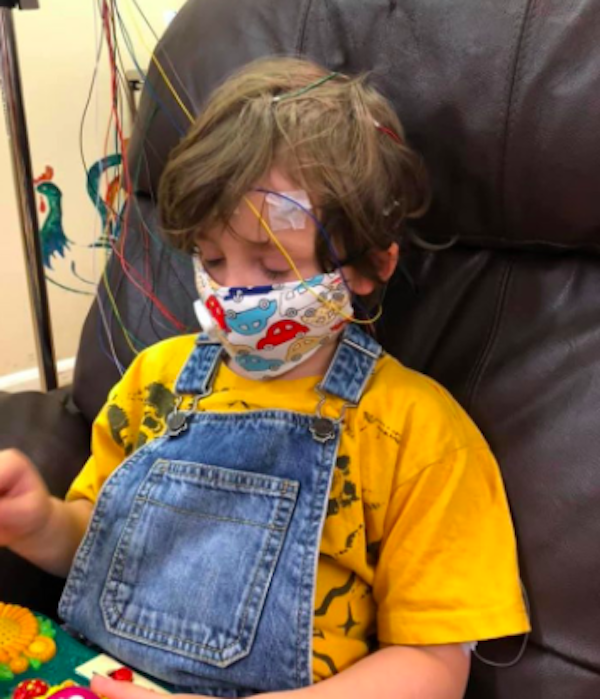So, today I ticked a box.
Just a pen mark, on a bit of paper, so someone else could tick a box for their funding. No big deal, right? Except it was. It was a really big deal.
Please tick to confirm under which criteria you are eligible to visit:
- Life limiting or terminal illness
- Addition/social/emotional/behavioural/special education needs
- Disadvantaged background
- Impacted by the needs of a family member or by bereavement
- Wheelchair user
- Mobility issues
- Sensory impairment
When a friend of mine sent over some information about a great adventure farm, totally COVID-19 safe, as you get the place to yourself for two hours, I thought, “Great! We tick five out of seven boxes—we can have a day out, free from worry and anxiety about COVID-19 all day!”
Which was true. But I hadn’t banked on how hard ticking those boxes would be.
There is a level of denial that has come with facing a diagnosis for me.
A year ago, last May, my four-year-old girl—whose a twin—came down with a respiratory condition; it led to a lung collapse and lots and lots of hospital stays. The good news was that if we survived this bit, there was a chance that she would fully recover and be well again. It’s an acute and life-threatening, but not a long-term, life-limiting diagnosis. I dealt with all that was thrown at us.
But during this time, her twin brother started to have outbursts of hysterical crying—I put it down to him being a bit of a drama queen. Yet, when it happened, I knew something was very wrong. But at the time, he had a chest infection and I thought it was the pain.
Fast-forward six months, as we are awaiting for an ambulance for his sister, who due to a cold had a deterioration in breathing and oxygen levels, both of them were tucked up on the sofa with a high temperature—and then suddenly my boy starts to laugh. It’s a strange laugh; it turns into a scream, and back to a laugh. He sounded like one of those haunted house special effects.
His eyes started to roll as his body went rigid, and when he came around, his speech was distorted and mixed up. Without hesitation, I rang for an ambulance for him. To cut a long story short—one that involves medical professionals thinking I’m a nut job and assuring me you can’t laugh when having a seizure and these are not seizures—thanks to a good friend, paediatric nurse, and fellow epilepsy warrior, I was put in touch with some people who could help.
Hope for Hypothalamatic Survivors is a charity helping people with this very rare form of epilepsy, so rare that most medical professionals know nothing about it. With their support, I got a referral to a specialist neurologist and we had confirmation that he was having gelastic (laughing) and dacrystic (crying) seizures that are almost always caused by a hypothalamatic hematoma (brain tumour).
Now I could write to you about the many things that come with that: the depression he suffers, the hyper excitement he can’t calm down, the fact that sometimes the seizures damage neurological pathways and we have to work on building new ones, or how he could count to 20, but now we are building up from three. I could tell you about the difficulty of getting any kind of diagnosis, which is something I’m sure any parent of an additional needs child could tell you about. But, mostly, what I notice is that most of the time, he seems like a normal, happy, beautiful little boy.
Which makes that small phrase, almost always, a little tricky. My logical brain hears that the MRI will almost certainly confirm what we already suspect, but me, the mother, hears, “Well sometimes it’s not that bad, and he’s not that bad.”
Almost always contains “almost.” Almost—that word is the bit of hope your heart holds onto. Maybe, just maybe, there is the small chance that it’s not a brain tumour, but some awful mistake. It will go away or certainly not get worse. Almost is not always.
I started to accept as the months rolled on how little things deteriorated and new challenges crept in, each one pointing more strongly toward confirmation of the diagnosis that I’m both fighting for and dreading.
Then one day, someone offers us some support. But I need to tick a box; I’ve spent two decades of my life working with families who tick those boxes. I’ve seen the heartbreak, the struggles, the exhaustion, and the fights. I’ve helped them tick those boxes and access that support. And yet, when its’ me—there is a denial. An unreality. Even as I write this, part of my brain says, “We don’t tick those boxes, that’s not us!”
When I looked at our “case” as just a case, I could see that yes, we have a life-limiting illness, and there are additional needs with that. Both children are impacted by the needs of the other child, and both now have sensory issues. I had to force myself to look up disadvantaged backgrounds, because as a professional woman, a therapist, we could not fit that bracket, surely. My brain said, “Hmm, single parent on a low income, getting lower each day as you take time off for medical appointments, COVID-19, and facing redundancy—and yep the litmus test is: do you meet criteria for free school meals? Yes, well tick that box!”
Still, I can’t bring myself to tick those boxes, so I get around it. I email with our story, and not surprisingly, we get accepted and offered a place the next day.
On arrival, I’m given the form and those damn boxes. I hesitate. I sit and it takes way longer than it should to just tick a box. I tick three (life-limiting illness, disadvantaged background, and impact by needs of other) and hand it back quickly before I change my mind. In that moment, there is a lot of cognitive dissonance making me uncomfortable. I tell myself that it’s just a box-ticking exercise, and let myself live in denial.
But later, at home, when everyone else is asleep, I cry. I cry hard, because that simple action of ticking a box, for a small bit of support, makes it just that bit more real—it chips away at the denial and hope that keeps me able to face the challenge each day.
But perhaps that is how it needs to be done; that defence broken down little by little, because to face the diagnosis full-on in one go would be overwhelming. Perhaps to do it a little by little each days means that I also build up the strength to deal with it.
I wonder how many other parents face that same dilemma: do we tick that box or pretend to ourselves that we don’t need to?
Accessing the support available makes it that bit more real. It’s easier to battle alone, because then in some ways it’s not real. Because each time you tick that box, it means admitting to yourself that there is no going back to how it was before. Just as the box is ticked in ink not pencil, you can’t erase the knowledge and go back to the normal that was. Each new box you tick means admitting to a new reality and facing a new unknown future.
So, next time you see a parent hesitate to tick a box or to agree to support, know that maybe in that moment they need you to reach out: to tell them it might not be okay, but they will get through it. That just as they have the ability to tick that damn box, they have the ability to meet each new day and each new challenge. That it’s okay to tick that damn box and get some support because it’s already real, but also that it’s okay to wish it wasn’t.
Maybe they just need you to offer your compassion and patience as ticking that box might be the hardest thing they did that day.
To find out more about gelasic seizures and the work that Hope for Hypothalamatic Hematoma does, visit here.











Read 2 comments and reply